
Virtual Presence and Online Communication
Kathryn Dewing and Anna North recently discussed some of the differences and impacts of working and communicating in an online world compared to that of a traditional in-person setting. This initial conversation led to further research and exploration of how communication has adapted to fit the needs of the virtual world in which many individuals are working. This article details their findings.
Summary
"The single biggest problem in communication is the illusion that it has taken place." - George Bernard Shaw
Having joined MERU during the depths of the COVID pandemic, I have not yet had the pleasure of meeting my co-workers in person. When discussing this with a colleague, she mentioned how most of her work was conducted online even before the pandemic and that when she meets people in person they are often surprised by her height. In fact, she finds her height valuable in creating a level of confidence and asserting a presence. Conversely, I am on the shorter side (5’2”) and often find that at events and conferences, when in group conversations, I am often talked over and must find other ways to demonstrate presence.
What we have noticed is that, as we communicate in an online world, these physical differences have reduced in impact and have led us to alter our style of communication. This made us curious as to how, in general, communication has adapted to suit the needs of an online world.
What we found was:
- Although professional interactions have shifted online, body language, tone of voice and words chosen all remain essential communication tools
- Each of these tools needs to be adapted for optimal online communication to occur
- Mastery of the technology available is crucial to effective communication
Methodology
We reviewed over 25 articles with tips and tricks on how to convey presence and communicate in an online world. This article collates these findings and maps them against the well-documented Mehrabian communication model to assist us in our evaluation. This model is particularly pertinent as it suggests that 55% of a message is communicated through body language which, in an online environment is limited to shoulders and above.
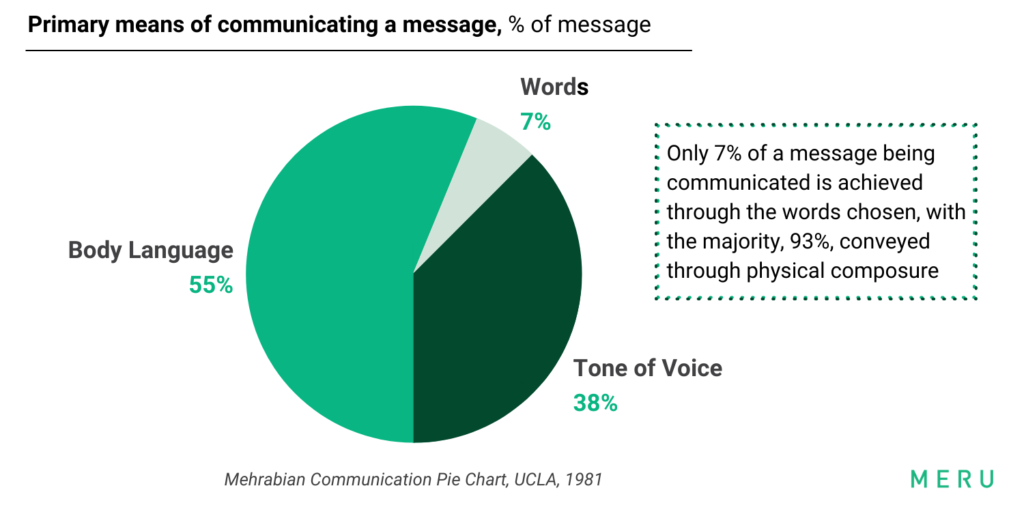
Body Language (55%)
"If language was given to men to conceal their thoughts, then gesture's purpose was to disclose them." - John Napier
Although, in most instances, the view of a person in online communications is limited to head and shoulders, body language remains a fundamental component of communication. There are many methods to enhance body language to assist in effective online communication.
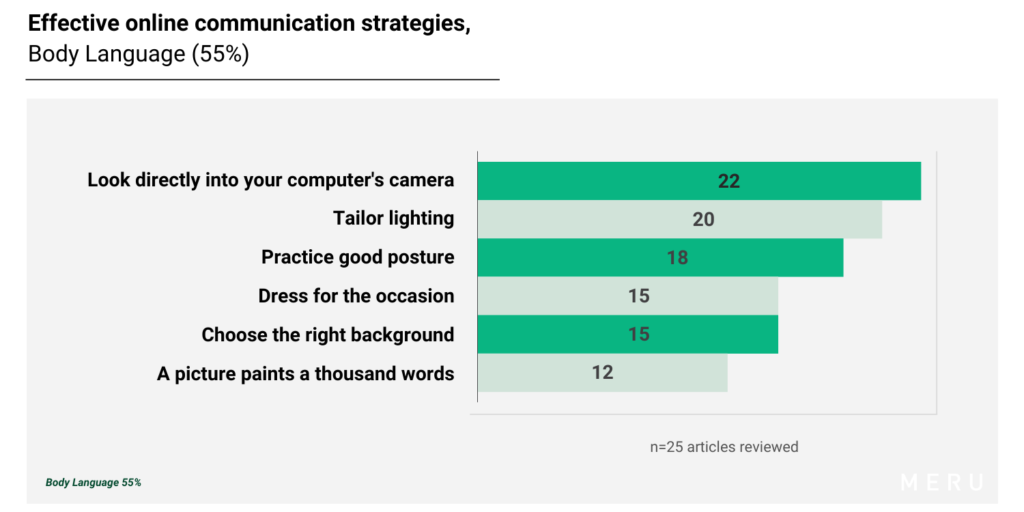
The need for eye contact when communicating is heightened in an online environment where other physical communication methods are limited.
Tip: Some viewers turn off their self-view so they aren’t distracted by their own image
To effectively use facial expressions and gestures to emphasize your points it is important to ensure that your face is lit up so that people can see you.
Tip: If you are in a dimly lit or window-less room, put a lamp behind your laptop facing you to light up your face. If you wear glasses angle the light so that it is above head height and to the side so that you are not looking towards it, this will reduce glare
Good open posture enhances your ability to communicate and is also an indicator that you have confidence in what you are saying.
Tip: An adjustable standing desk will enable you to alter you seating and standing position accordingly
At MERU we often discuss how best to dress when working with a client to ensure that we are professional but also make the client feel comfortable. This is key to helping build a relationship with the client that is based on trust and comradery.
Tip: Dress professionally from head to toe – no shirts with board shorts, otherwise you will not get the full effect of the confidence boost and may accidently show your unique outfit choices to those on the camera.
In a virtual world, your background and surroundings have a large impact on communications with colleagues and clients.
Tip: Use a virtual background and tailor it to the situation. For example, we recently attended a cocktail evening where the participants used the same background image of the bar to artificially simulate us all being in the same location
Turning off your camera sets a level of disconnection between yourself and those in the meeting and prevents them from reading your non-verbal cues.
Tip: Update your professional headshot on a regular basis to keep it fresh and representative of you
Tone of Voice (38%)
"We often refuse to accept an idea merely because the tone of voice in which it has been expressed is unsympathetic to us." - Friedrich Nietzsche
A suitable tone of voice and vocal pace is even more key to effective online communication as it enables you to create a presence that you would usually rely on your body language to communicate.
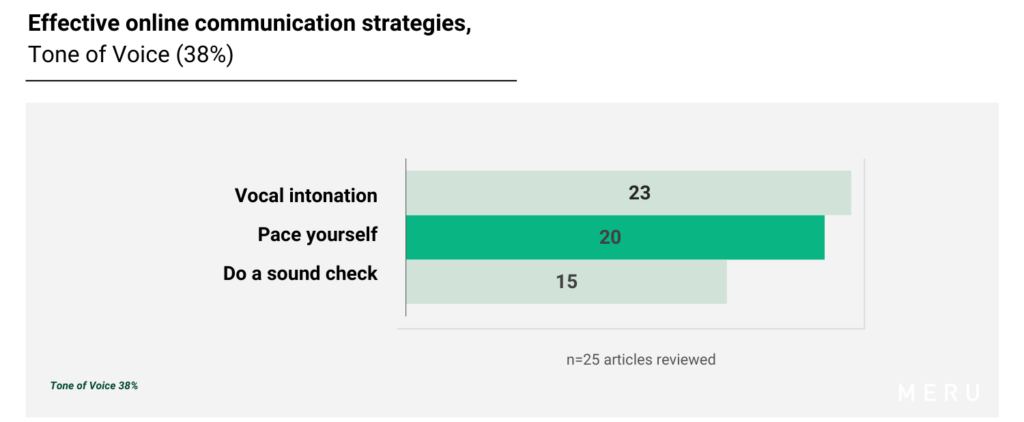
Change in vocal intonation is fundamental to emphasizing key takeaways of the message you are trying to convey, and it also keeps the audience engaged.
Tip: Try to balance talking and listening, reemphasizing key points to show you are listening and to keep the participants engaged
Pace of messaging is key for effective delivery. The power of the pause is significant as it gives people time to absorb the message and can act as a way of emphasizing a point.
Tip: Slow down and choose your words – Fewer, well-chosen words spoken once are more meaningful than the same idea repeated in slightly different ways
Make sure that you can clearly be heard. If the audience cannot effectively hear you, they will likely tune out or leave the call.
Tip: Every platform is different, try joining the platform 5-10 minutes before the call to test sound quality and amend technical configurations as required
Words (7%)
"The most valuable of all talents is that of never using two words when one will do." - Thomas Jefferson
Top-down communication of well selected words is vital to creating a clear and impactful message and convincing the audience of your opinions.
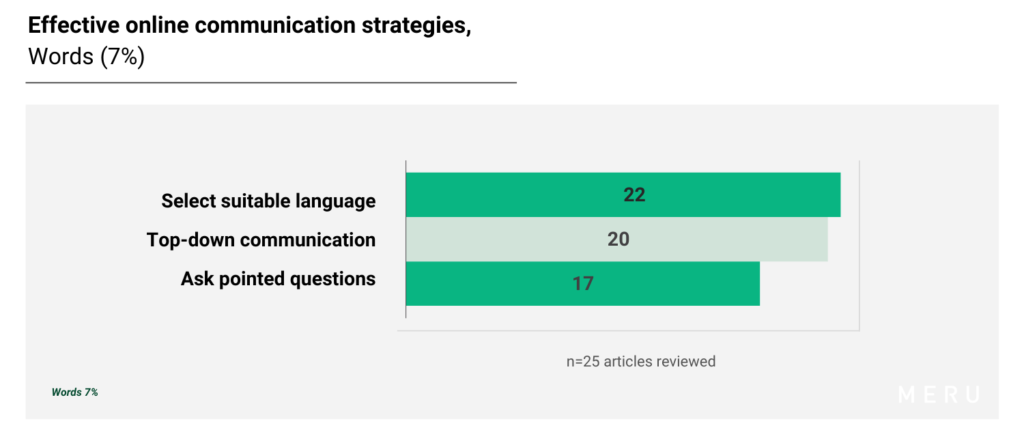
How often have you written a word and looked for its synonym to find that the listed word choices do not quite convey the essence of the message that you are trying to invoke? The English language has various subtleties in its words that can have a large impact on how someone perceives what you are saying.
Tip: Use descriptive language and examples / analogies to help listeners visualize
The key to top-down communication is to start with the overarching takeaway, then communicate the rationale.
Tip: If there are two ways of delivering a message, use the shorter one
To avoid too many people answering at once rather than ask “Are there any questions?” try “Who has a question about [specific point]?”
Tip: Set a ground rule that people state their names prior to speaking to make it easier to follow up offline
The Technology
"The great myth of our time is that technology is communication." - Libby Larsen
Technology provides many tools for enhancing communication but choosing the wrong tool or using it inappropriately can have the opposite effect.
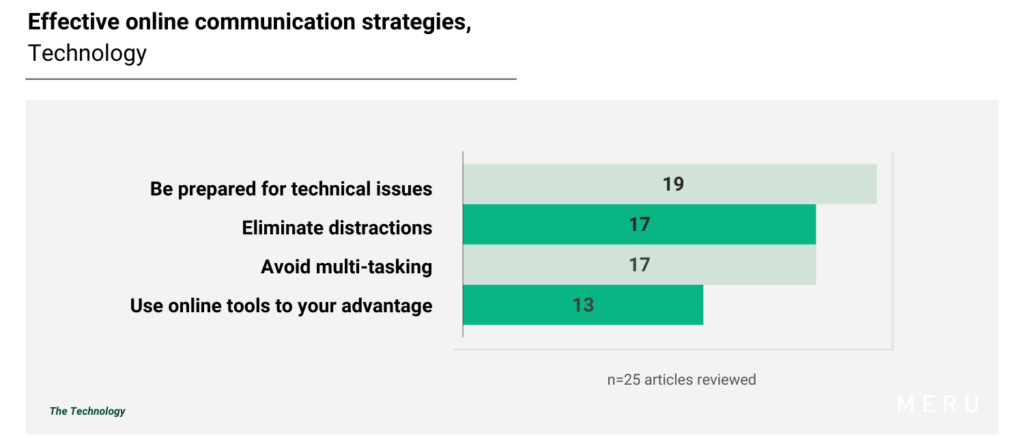
Technology and the issues that go alongside its use, creates hurdles to communication.
Tip: Have a back-up plan such as circulating documents prior to the meeting so that you can still talk to the document over a conference call if the virtual meeting rooms fails
Distractions come in a variety of forms, from those in your working environment (offline) to those on your screen (online). These need to be eliminated to keep yourself and meeting attendees engaged.
Tip: Shut down as many documents / tabs as possible before hosting a meeting so that you don’t inadvertently share information when sharing your screen
Anything you do that is not related to the meeting itself will prevent you from absorbing the content and providing non-verbal cues to the presenter.
Tip: If people are multi-tasking ask them direct questions on their opinion or understanding of what is being said to try and get them to reengage
Interactive features can be used to increase participant engagement.
Tip: If poll responses allow, look to see who is not responding to the online tools and then adapt your delivery to engage them further
Conclusion
It is clear that, although 40 years old, the Mehrabian Communication model still holds relevance today and body language, tone of voice and words chosen all remain essential communication tools in an online environment. However, for effective online communication to occur communication tools need to be adapted. For example, to ensure that eye contact is made with meeting participants, it is important to look directly into the camera when talking, despite it potentially feeling unnatural. Further, mastery of technology, from avoiding technical issues to avoiding multi-tasking and distractions is key in ensuring that yourself and other participants are fully present in the meeting and that communication is effective.










